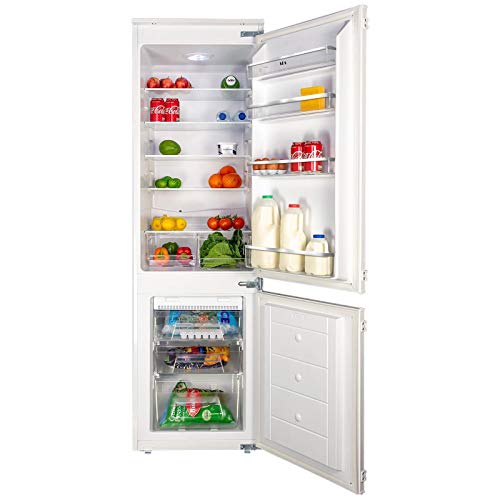What’s The Ugly Truth About Fridge Larder
Tips For Organizing Your Fridge Larder
A fridge’s larder can be the ideal place to store expired produce. You can also use smaller refrigerators to save money on energy costs!
It’s a great place for storing provisions like eggs, bread and hard cheeses. Fresh herbs also benefit from low moisture.
Keep It Organized
A fridge’s larder helps cut down on food waste and makes it easier to locate items when cooking. However, like any room in your home, the fridge can become messy and chaotic. Here are some ways to keep your refrigerator running smoothly and organized.
Take inventory
The most crucial aspect of organizing your kitchen is taking inventory, says Holly Blakey, www.frydge.uk a professional organizer at Breathing Room. “Take everything out, verify expiration dates and clean the surfaces.” Throw out expired foods, toss or freeze leftovers and dispose of all food items that aren’t likely to be consumed before they go bad.
When you restock your fridge, make sure the items you use most often used are placed front and in the middle, Blakey advises. Then, you can put away the items that aren’t used in the back and the bottom of your fridge.
Organize Your Freezer
If you have a chest-freezer, you can organize it with clear storage bins which will allow you to locate foods more easily. Clearly label each bin and put similar items together. For instance, you could put a bin in the pantry to store condiments, another for sodas, and another for cheese sticks. You can also make use of a lazy Susan for condiments and other commonly used items to prevent them from being lost in the back.
Keep food items that require coldest temperatures at the back of a side-by-side fridge, and food items that require warmer temperatures towards the front of. The lower shelf is ideal for milk, cream or butter (it doesn’t melt) yogurt and other items that don’t need consistent temperatures. And the crisper drawers are ideal to store spillage from produce.
Drawer dividers make your refrigerator more efficient and are simple to put in. They’ll prevent your fruits and vegetables from splattering around, and prevent them from rotting before you are able to use them. In addition, they’ll make sure your drawers stay cleaner and well-organized. To prolong the longevity of tender herbs, keep them in water. (Mason Jars that hold one inch of water work great.) Alternately, you can purchase an herb saver that you can put in your refrigerator.
Keep it Visible
Keeping your fridge organized will help you reach for healthy foods that will keep you feeling full and content throughout the day. Make sure that all of your food containers are transparent so you can easily see the contents. This will tell you the remaining days on the expiration date and ensure that you don’t store food that’s beyond its expiration date.
Get your fridge’s larder started with a thorough cleaning by scrubbering the shelves, drawers and racks with warm water and dish soap. Then give your fridge an excellent wipe down to get rid of any gross crumbs and spills that might have accumulated over the course of time.
After everything is dry and clean now is the time to replenish your refrigerator. Start by putting your cheeses and deli meats in the drawer. Then, move to the produce drawer. This is where you should store greens that are leafy because they will wilt easily. Make sure it is at least three-quarters full to ensure freshness.
You can store bulky items in the pantry drawers of certain refrigerators, including tray sets for parties and large bags of frozen vegetables. You can also use this space to store condiments such as mayonnaise, mustard, and ketchup as well as nuts and other canned goods. Be careful not to store milk here though, as it can go bad quickly due to the fluctuating temperatures within the fridge door.
Also, the refrigerator’s back should be reserved for jarred meals such as salad dressings, salad dressings, and other condiments that will last longer. Consider using a riser in order to raise jars so that they are easier to read. This will prevent you from having to open and close the lid a few times, which will increase the life of your condiments.
Label each bin using a marker, or use stickers that are able to be easily read. This will help your family members easily identify what each container holds and will make it easier for you to find what you’re looking for. Adding some labeled bins is a great way to clear your fridge and reduce the amount of plastic waste you produce.
Keep Cool
A fridge with a good larder can keep foods at the right temperature to protect against spoiling and also slow down the growth of bacteria. Larders can be incorporated into existing cabinetry or stand on their own. They are typically located on the north-facing side of your home to reduce exposure to sun, and may have extra insulation or a ventilation system to prevent heat from entering the food storage area. They are also usually built with thicker walls and less windows to keep the inside at a lower temperature than other parts of your home.
The larder should include a drawer for each type of food item, including meat and vegetables. Each drawer can be programmed to maintain the proper temperature. This ensures that the burgers and chicken will be cooked to perfection, and that the salad greens don’t get excessively wilted. Larder drawers can also be set to a low-humidity setting for vegetables and fruits that release a lot of moisture, like cucumbers or tomatoes.
To preserve cheese, you can keep it in other drawers in the refrigerator. Wrapped in greaseproof paper, Clingfilm or greaseproof film, you can keep it fresher for longer. drinks, non-perishable condiments, such as ketchup, eggs, and water can also be kept in the fridge’s door. The door of the refrigerator is not the ideal location to store milk as it tends to be warmer and less stable than other drawers.
To create a more streamlined appearance, you can organize small containers to make them more easily visible. This is beneficial for family members who are moving around and need food. Labelling shelves and bins to indicate what needs to be eaten first can also be helpful, especially in the case of family members who aren’t used to reading labels!
A larder can also be an ideal place to store leftovers as well as a selection of food-safe plastic and glass containers for storage, which are ideal for holding smaller portions of ingredients. Having these ready for quick meals is a great way to save time and money when shopping. And if you have a clean and tidy fridge, with a dedicated space for storing these, it will be much easier to stay on top of your food budget!
Keep It Fresh
The best ways to organize your fridge reduce food waste and help your healthy groceries last longer. A few smart strategies ensure that fresh food items are kept at the proper temperature and make it easier to see what you have and where it is.
Crisper drawers are found in the majority of refrigerators. They alter the flow of air and increase humidity, thus extending the shelf life of vegetables and fruits. It is essential to use these drawers properly. Mixing fruits and greens can cause the former, such as the greens to wilt or spoil prematurely due to the ethylene produced. It is also important to separate different types of fruits and vegetables and place them in drawers that are appropriate for the type of produce.
The door shelves are the warmest part in the fridge. They are best used for items that do not require extra cold or specific conditions of storage, such as salad dressing jars jams, chutneys, jams and drinks with a long shelf life (anything purchased in bulk and with the same expiration date). The top shelf is ideal for beverages that can be stored upright without leaks, such as milk and water.
Refrigerator drawers can be tricky to keep organized with items moving around and getting mixed up, but there are some simple tips to aid. First, you should invest in refrigerator drawer dividers that keep produce separated and prevent them from squishing against each one. The ability to organize by size is useful. Keep produce that is similar in height on the same shelf, and don’t keep things that aren’t the same size next to each other — raw meat shouldn’t be stored in the same drawer with cooked ham!
A thermometer is an additional essential item to have in your fridge. It’s an inexpensive, easy-to-use tool that can ensure that your refrigerator is at the ideal temperature to keep your food in the best condition and is freshest.
Keep a stash in your fridge of plastic bags for storing produce without containers. The bag’s moisture keeps vegetables from turning brown. For herbs that usually wilt in days they can be kept fresher for longer by washing them before putting them in a water glass. This is as effective as a plastic sack at conserving moisture.

